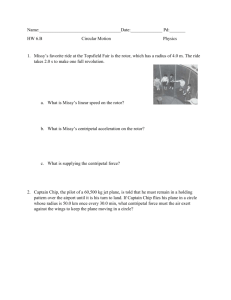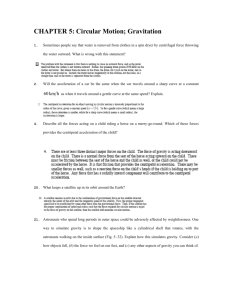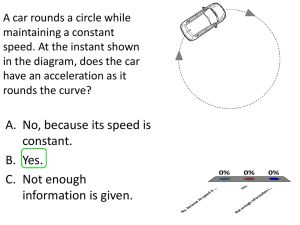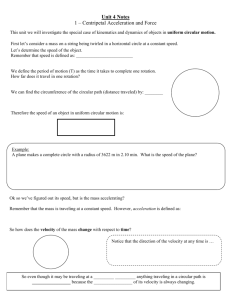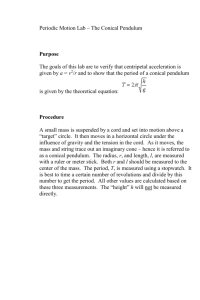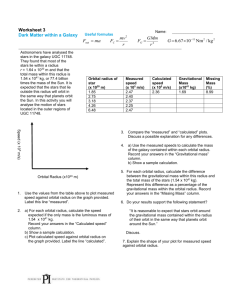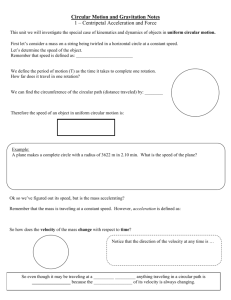Unit 5 Review
advertisement
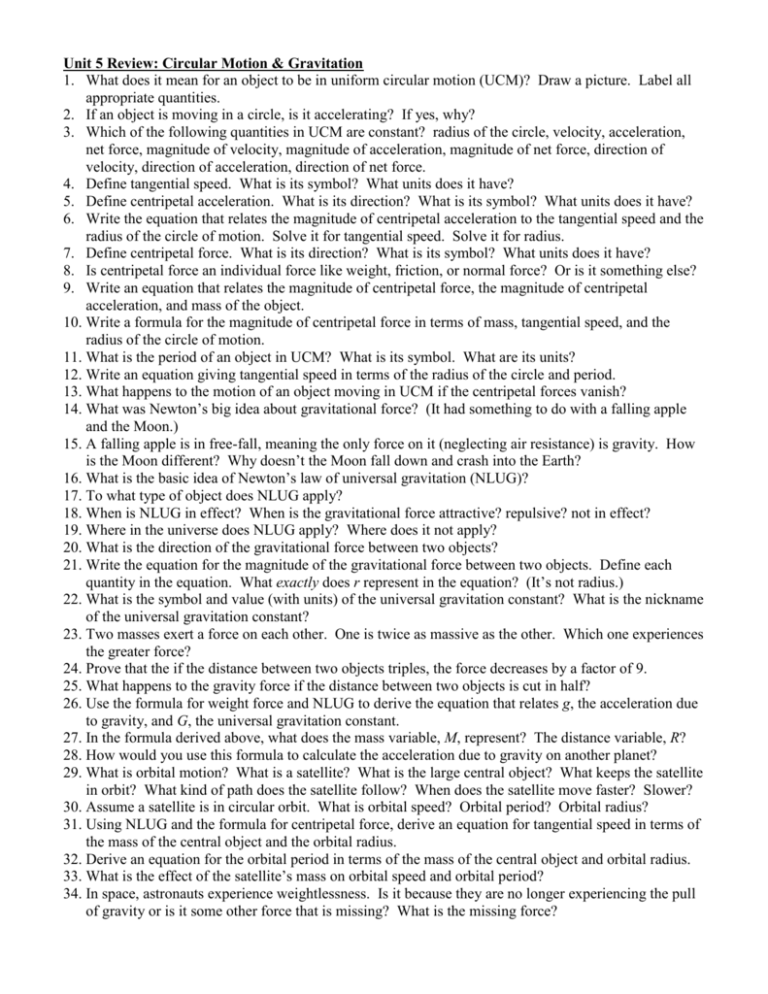
Unit 5 Review: Circular Motion & Gravitation 1. What does it mean for an object to be in uniform circular motion (UCM)? Draw a picture. Label all appropriate quantities. 2. If an object is moving in a circle, is it accelerating? If yes, why? 3. Which of the following quantities in UCM are constant? radius of the circle, velocity, acceleration, net force, magnitude of velocity, magnitude of acceleration, magnitude of net force, direction of velocity, direction of acceleration, direction of net force. 4. Define tangential speed. What is its symbol? What units does it have? 5. Define centripetal acceleration. What is its direction? What is its symbol? What units does it have? 6. Write the equation that relates the magnitude of centripetal acceleration to the tangential speed and the radius of the circle of motion. Solve it for tangential speed. Solve it for radius. 7. Define centripetal force. What is its direction? What is its symbol? What units does it have? 8. Is centripetal force an individual force like weight, friction, or normal force? Or is it something else? 9. Write an equation that relates the magnitude of centripetal force, the magnitude of centripetal acceleration, and mass of the object. 10. Write a formula for the magnitude of centripetal force in terms of mass, tangential speed, and the radius of the circle of motion. 11. What is the period of an object in UCM? What is its symbol. What are its units? 12. Write an equation giving tangential speed in terms of the radius of the circle and period. 13. What happens to the motion of an object moving in UCM if the centripetal forces vanish? 14. What was Newton’s big idea about gravitational force? (It had something to do with a falling apple and the Moon.) 15. A falling apple is in free-fall, meaning the only force on it (neglecting air resistance) is gravity. How is the Moon different? Why doesn’t the Moon fall down and crash into the Earth? 16. What is the basic idea of Newton’s law of universal gravitation (NLUG)? 17. To what type of object does NLUG apply? 18. When is NLUG in effect? When is the gravitational force attractive? repulsive? not in effect? 19. Where in the universe does NLUG apply? Where does it not apply? 20. What is the direction of the gravitational force between two objects? 21. Write the equation for the magnitude of the gravitational force between two objects. Define each quantity in the equation. What exactly does r represent in the equation? (It’s not radius.) 22. What is the symbol and value (with units) of the universal gravitation constant? What is the nickname of the universal gravitation constant? 23. Two masses exert a force on each other. One is twice as massive as the other. Which one experiences the greater force? 24. Prove that the if the distance between two objects triples, the force decreases by a factor of 9. 25. What happens to the gravity force if the distance between two objects is cut in half? 26. Use the formula for weight force and NLUG to derive the equation that relates g, the acceleration due to gravity, and G, the universal gravitation constant. 27. In the formula derived above, what does the mass variable, M, represent? The distance variable, R? 28. How would you use this formula to calculate the acceleration due to gravity on another planet? 29. What is orbital motion? What is a satellite? What is the large central object? What keeps the satellite in orbit? What kind of path does the satellite follow? When does the satellite move faster? Slower? 30. Assume a satellite is in circular orbit. What is orbital speed? Orbital period? Orbital radius? 31. Using NLUG and the formula for centripetal force, derive an equation for tangential speed in terms of the mass of the central object and the orbital radius. 32. Derive an equation for the orbital period in terms of the mass of the central object and orbital radius. 33. What is the effect of the satellite’s mass on orbital speed and orbital period? 34. In space, astronauts experience weightlessness. Is it because they are no longer experiencing the pull of gravity or is it some other force that is missing? What is the missing force? Vocabulary for Unit 5 Newton’s laws of motion circular motion tangential speed radius of a circle centripetal acceleration centripetal force to orbit an orbit Newton’s orbital cannon free-fall satellite gravitational force Newton’s law of universal gravitation (NLUG) constant of universal gravitation Kepler’s laws of planetary motion ellipse semi-major axis elliptical orbit circular orbit orbital radius orbital speed orbital period Facts to Know: Newton’s laws of motion: 1. An object’s motion stays constant (speed and direction) unless acted on by a net force. 2. The net force acting on an object equals the object’s mass multiplied by its acceleration. 3. For every force acting on an object there is a corresponding force, equal in magnitude and opposite in direction, acting on the object causing the force. Circular motion: 1. The circumference of a circle is the distance around the circle and is 2 times the radius. 2. Tangential speed is the speed of an object moving in a circle. 3. The instantaneous velocity of an object moving in a circle is directed along the tangent line. 4. Centripetal acceleration and centripetal force are directed toward the center of the circle of motion and are perpendicular to velocity. Newton’s Law of Universal Gravitation: 1. The gravitational force that holds the moon in orbit also makes an apple fall to the ground. a. The Fg in the NLUG equation is the same physical quantity as Fg = mg b. The gravitational force exist between every two objects with mass. c. The gravitational force gets stronger very rapidly as objects get closer together. 2. The gravitational force is always attractive and directed toward the center of the other object. 3. The acceleration due to gravity on the surface of the Earth, g, is related to the constant of universal gravitation, G, by a simple formula involving the mass and radius of the Earth. Planetary Motion: 1. Kepler’s first law says that all planets (satellites) move in elliptical orbits with the sun (large central mass) at one of the foci. 2. Kepler’s second law says that planets (satellites) sweep out equal areas in equal times. 3. Kepler’s third law says that the square of the orbital period of a planet (satellite) is proportional to the cube of the semi-major axis of its orbit. For a circular orbit, the semi-major axis is just the orbital radius.




